![]()
![]()
![]()
Use LEFT and RIGHT arrow keys to navigate between flashcards;
Use UP and DOWN arrow keys to flip the card;
H to show hint;
A reads text to speech;
360 Cards in this Set
- Front
- Back
- 3rd side (hint)
|
sternum |
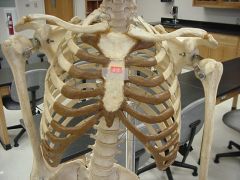
|
-flat bone that consists of manubrium, the body, and the xiphoid process -common site for bone marrow biopsy |
|
|
manubrium |
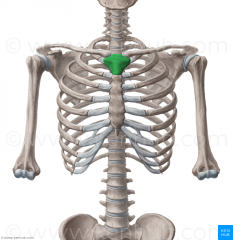
|
-component of sternum -has a superior margin (jugular notch) and clavicular notches on each side for articulation with the clavicle -also articulates with cartilage of first rib, upper half of second rib, and the body of sternum at the sternal angle |
|
|
xiphoid process |
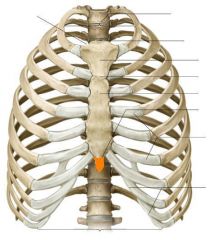
|
-flat cartilaginous process that ossifies slowly from the central core after middle age -lies at level of T10 -joins with the body of sternum at xiphisternal joint |
|
|
sternal angle |
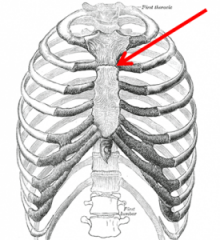
|
-junction between the manubrium and the body of sternum -located where: second ribs articulate; the aortic arch begins and ends; trachea bifurcates |
|
|
suprasternal notch |
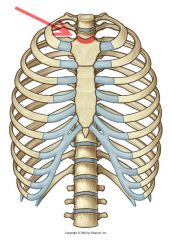
|
aka jugular notch |
|
|
xiphisternal junction |
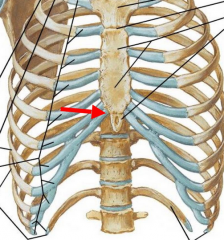
|
level with the ninth thoracic vertebra -lower border of the heart, upper surface of the liver and diaphragm |
|
|
clavicle |
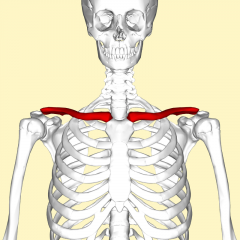
|
-together with scapula forms the pectoral girdle, which connects the upper limb to the axial skeleton at the sternoclavicular joint -joins the scapula at the acromioclavicular joint -first bone to ossify (intramembranously), last to finish (at 21) -frequently fractured (from falls on shoulder or outstretched hand) in the junction between middle and lateral thirds, resulting in upward displacement of the proximal fragment (pull of the sternocleidomastoid) and downward displacement of the distal fragment (deltoid and gravity) |
|
|
sternal articular surface of the clavicle |

|
articulates with clavicular notches of manubrium |
|
|
acromial articular surface |
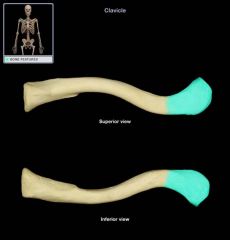
|
articulates with acromion of scapula |
|
|
scapula |
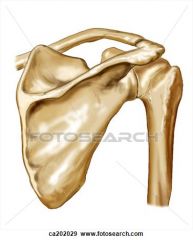
|
composed of spine, acromion, coracoid process, scapular notch, glenoid cavity, and supraglenoid and infraglenoid tubercles -scapular notch is bridged by the superior transverse scapular ligament converting it to a foremen and permitting passage of the suprascapular nerve -calcification of the superior transverse scapular ligament may trap or compress the suprascapular nerve, affecting the supraspinatus and infraspinatus |
|
|
supraspinous fossa |
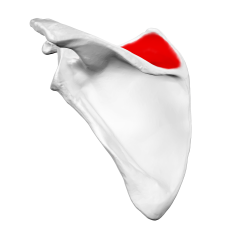
|
|
|
|
infraspinous fossa |
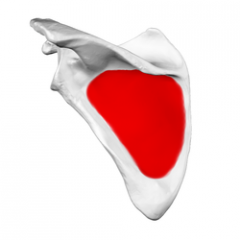
|
|
|
|
spine of scapula |
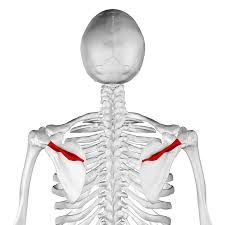
|
-trianglular-shaped process that continues laterally as the acromion -divides the dorsal surface into supraspinous and infraspinous fossae -provides origin fro deltoid and insertion for trapezius |
|
|
acromion |

|
-lateral end of the spine of scapula -articulates with clavicle -provides origin for deltoid and insertion for the trapezius |
|
|
coracoid process |

|
-extends anteriorly from the scapula -provides the origin of the coracobrachialis and biceps brachii and the insertion of the pectoralis minor |
|
|
subscapular fossa |
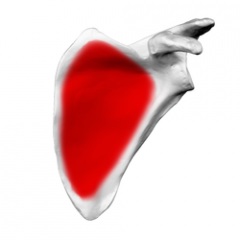
|
|
|
|
glenoid cavity |

|
-deepened by the glenoid labrum for the head of the humerus |
|
|
infraglenoid tubercle |
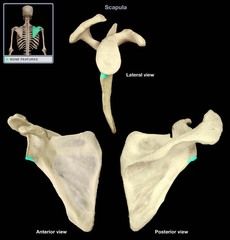
|
provides origin for the tendon of the long head of the biceps brachii |
|
|
supraglenoid tubercule |
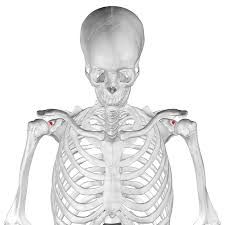
|
provides origin for the tendon of the long head of the triceps brachii |
|
|
humerus |
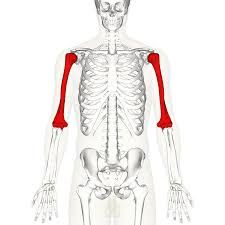
|
-head: articulates with scapula at glenohumeral joint -anatomical neck: indentation distal to the head that provides for the attachment of the fibrous joint capsule -greater and lesser tubercles -bicipital groove -surgical neck: -narrow area distal to the tubercles that commonly fractures; in contact with the axillary nerve and the posterior humeral circumflex artery -deltoid tuberosity -radial groove -trochlea -capitulum -coronoid fossa -radial fossa -lateral epicondyle -medial epicondyle |
|
|
greater tuberosity of the humerus |
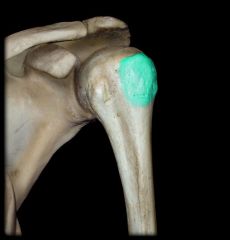
|
-lies lateral to the anatomic neck -provides attachment for the supraspinatus, infraspinatus, and teres minor -fracture occurs by direct trauma or violent contraction of supraspinatus, and results in loss of rotator cuff function |
|
|
lesser tuberosity of the humerus |
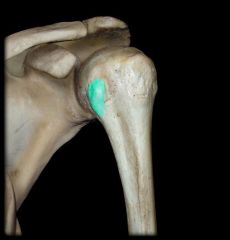
|
-lies on the anterior medial side of the humerus, just distal to the anatomic neck -provides an insertion for the subscapularis -fracture accompanies posterior dislocation of the shoulder |
|
|
bicipital groove of humerus |

|
-lies between the greater and lesser tubercles -lodges the tendon of the long head of the biceps brachii -bridged by the transverse humeral ligament to restrain the tendon -provides insertions for the pectoralis major on its lateral lip, there teres major on its medial lip and the latissimus dorsi on its floor |
|
|
radial groove of humerus |
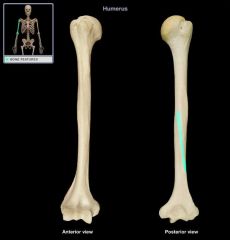
|
-contains the radial nerve -separates the origin of the lateral head of the triceps above and the origin of the medial head below -fracture of the shaft of the humerus may result in injury to the radial nerve in the spiral groove |
|
|
olecranon fossa |
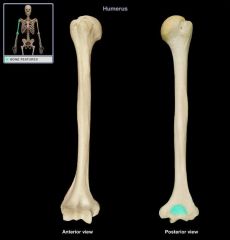
|
-posterior depression above the trochlea -houses the olecranon of the ulna on full extension of the arm |
|
|
medial epicondyle of humerus |

|
-projects from the trochlea -has a groove on the back for the ulnar nerve and superior ulnar collateral artery -provides attachment sites for the ulnar collateral ligament, the pronator teres, and the common tendon for the forearm flexor muscles -fracture may damage the ulnar nerve -groove behind medial epicondyle allows access to ulnar nerve (funny bone) |
|
|
lateral epicondyle of humerus |

|
-projects from the capitulum -provides the origin of the supinator and extensor muscles of the forearm |
|
|
deltoid tuberosity |
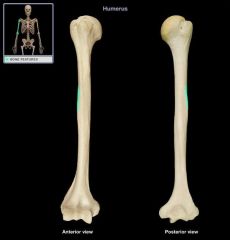
|
-V-shaped roughened area on the lateral aspect of the midshaft that marks the insertion of the deltoid |
|
|
radial fossa |

|
-anterior depression above the capitulum -is occupied by the head of the radius during full flexion of the elbow joint |
|
|
coronoid fossa |

|
-an anterior depression above the trochlea of the humerus -accommodates the coronoid process of the ulna on flexion of the elbow |
|
|
capitulum |
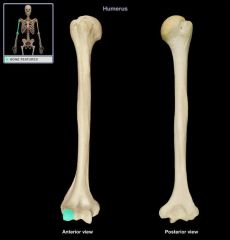
|
-lateral articular surface of the humerus -articulates with the head of the radius |
|
|
trochlea |

|
-medial articular surface of the humerus -shaped like a sppol -articulates with the trochlear notch of the ulna |
|
|
ulna |
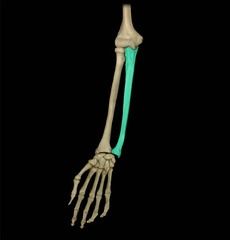
|
-longer and more massive of the forearm bones; situated medially; stabilizing -olecranon -coronoid process -trochlear notch -ulnar tuberosity -radial notch -head (distal end): articulates with the articular disk of the distal radioulnar joint; has styloid process |
|
|
olecranon |

|
-curved projection on the back of the elbow -provides attachment for triceps tendon |
|
|
coronoid process |
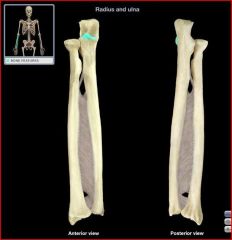
|
-located below trochlear notch -provides attachment for the brachialis |
|
|
trochlear (semilunar) notch |
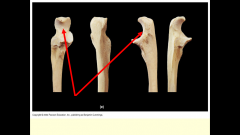
|
-recieves the trochlea of the humerus |
|
|
radial notch |
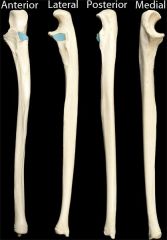
|
-accommodates the head of the radius |
|
|
ulnar tuberosity |
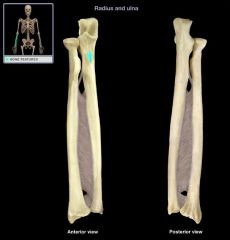
|
-roughened prominance distal to the coronoid process -provides attachment for brachialis |
|
|
styloid process of ulna |
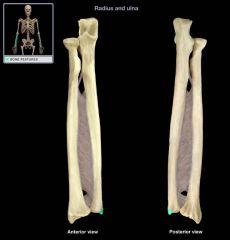
|
-doesn't reach the wrist |
|
|
radius |
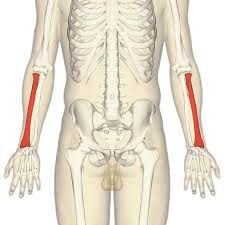
|
-shorter than ulna; situated laterally -characterized by displacement of the hand dorsally and radially when fractured at its distal end (Colles' fracture) -head (proximal end): articulated with capitulum and radial notch of ulna; surrounded by annular ligament -distal end: articulates with the proximal row of carpal bones -radial tuberosity -styloid process |
|
|
radial tuberosity |
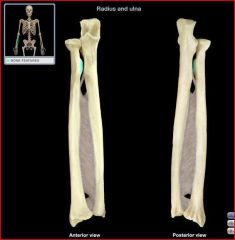
|
-oblong prominance just distal to the neck -provides attachment site for the biceps brachii tendon |
|
|
styloid process of radius |
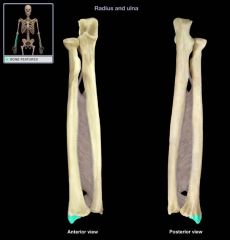
|
-located at the distal end of the radius and is about 1 cm distal to that of the ulna -provides insertion for brachioradialis muscle -can be palpated in the proximal part of the anatomic snuffbox between the extensor pollicis longus and brevis tendons |
|
|
carpal bones |

|
-arranged in two rows of four -scaphoid, lunate, triquetrum, pisiform, hamate, capitate, trapezoid, trapezium -scaphoid, lunate, and triquetrum articulate with radius |
|
|
anterior cutaneous branches of intercostal nerves |
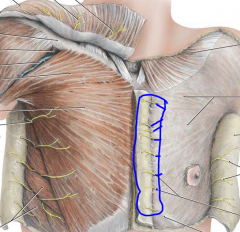
|
|
|
|
anterior and posterior branches of the lateral cutaneous branches of intercostal nerves |

|
|
|
|
pectoralis major |

|
-origin: medial half of clavicle; manubrium and body of sternum; upper six costal cartilages -insertion: lateral lip of intertubercular groove of humerus -nerve: lateral and medial pectoral -action: flexes, adducts, and medially rotates arm |
|
|
deltopectoral triangle |
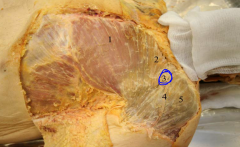
|
-the separation of the deltoid and pectoralis major -contains part of the cephalic vein and the deltoid branch of the thoracoacromial trunk |
|
|
cephalic vein |

|
-begins as a radial continuation of the dorsal venous network, runs on the lateral side, and is connected with the basilic vein by the median cubital vein -ascends along the lateral surface of the biceps, pierces the brachial fascia, and lies in the deltopectoral triangle -pierces the costocoracoid membrane of the clavipectoral fascia and empties into the axillary vein |
|
|
lateral pectoral nerve |
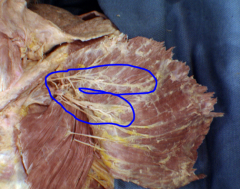
|
-C5-C7 -branches from the lateral cord of the brachial plexus -inntervates the pectoralis major (also supplies pectoralis minor by means of a nerve loop) -is accompanied by the pectoral branch of the thoracoacromial artery |
|
|
medial pectoral nerve |

|
-branches from the medial cord of the brachial plexus -passes forward between the axillary artery and vein and forms a loop in front of the axillary artery with the lateral pectoral nerve -enters and supplies the pectoralis minor and reaches the overlying pectoralis major |
|
|
thoracoacromial trunk |
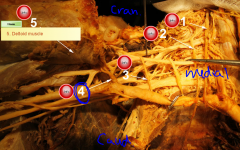
|
-short trunk from the first or second part of the axillary artery and has pectoral, clavicular, acromial, and deltoid branches |
|
|
axillary artery |

|
-a continuation of the subclavian artery -gives off branches: superior thoracic, thoracoacromial, lateral thoracic, subscapular, and anterior and posterior humeral circumflex arteries -extends from the outer border of the first rib to the inferior border of the teres major muscle, where it becomes the brachial artery |
|
|
lateral cord of the brachial plexus |
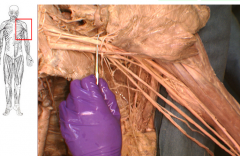
|
-composed of the anterior divisions of the upper and middle trunks -branches into the lateral pectoral nerve and the musculocutaneous nerve -joins the remaining medial branch to become the median nerve |
|
|
medial cord of the brachial plexus |
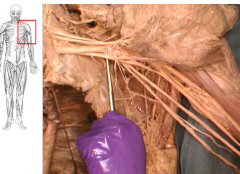
|
-composed of the anterior division of the lower trunk -branch off: medial pectoral nerve; medial brachial cutaneous nerve; medial antebrachial cutaneous nerve; ulnar nerve -joins the remaining lateral cord to form the median nerve |
|
|
pectoralis minor |
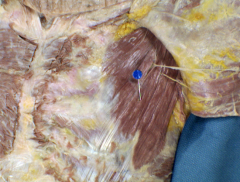
|
-origin: 3rd, 4th, and 5th ribs -insertion: coracoid process of the scapula -nerve: medial (and lateral) pectoral -action: depresses scapula; elevates ribs |
|
|
lateral thoracic artery |
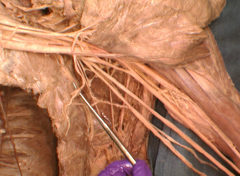
|
-branches off the axillary artery -runs along the lateral border of the pectoralis minor muscle -supplies the pectoralis major, pectoralis minor, and serratus anterior and the axillary lymph nodes |
|
|
serratus anterior |
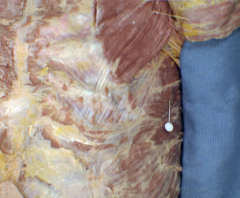
|
-origin: upper eight ribs -insertion: medial border of scapula -nerve: long thoracic -action: rotates scapula upward; abducts scapula with arm and elevates it above the horizontal |
|
|
long thoracic nerve |
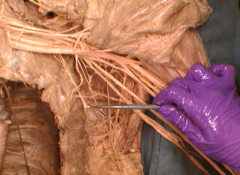
|
-C5-C7 -branches from the root of the brachial plexus -decends behind the brachial plexus and runs on the external surface of the serratus anterior muscle -supplies serratus anterior -when damaged causes winging of the scapula and makes elevating of the arm above a horizontal position impossible |
|
|
deltoid |
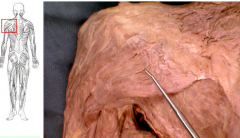
|
-origin: lateral third of the clavicle, acromion, and spine of scapula -insertion: deltoid tuberosity of humerus -nerve: axillary -action: abducts, adducts, flexes, extends, and rotated arm medially and laterally |
|
|
intercostobrachial nerve |
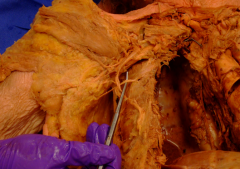
|
-the lateral cutaneous branch of the second intercostal nerve and emerges from the second intercostal space by piercing the intercostal and serratus anterior muscles -may communicate with the medial brachial cutaneous nerve |
|
|
external occipital protuberance of the skull |
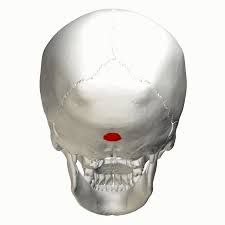
|
|
|
|
mastoid processes |
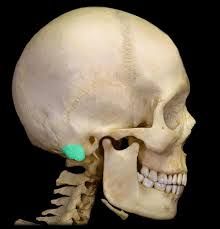
|
|
|
|
nuchal ligament |

|
-tough sheet lying in median plane -spans space between the skull and dorsal spinous process of the cervical vertebrae -supports passive elevation of the skull |
|
|
trapezius |
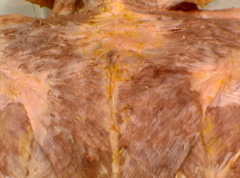
|
-origin: external occipital protuberance, superior nuchal line, ligamentum nuchae, spines of C7-T12 -insertion: spine of scapula, acromion, and lateral third of clavicle -nerve: spinal accessory nerve, C3-C4 -action: adducts, rotates, elevates, and depresses scapula |
|
|
latissimus dorsi muscle |

|
-origin: spines of T7-T12, thoracodorsal fascia, iliac crest, ribs 9-12 -insertion: floor of bicipital groove of humerus -nerve: thoracodorsal -action: adducts, extends, and rotates arm medially; depresses scapula |
|
|
triangle of auscultation |
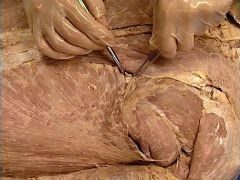
|
-bounded by the upper border of the latissimus dorsi, the lateral border of the trapezius, and the medial border of the scapula -floor formed by the rhomboid major -is the site where breating sounds can be heard most clearly, using a stethoscope |
|
|
spinal accessory nerve |
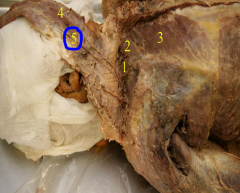
|
-runs deep to the sternocleidomastoid, lies on hte levator scapulae, and passes deep to the trapezius -supplies the sternocleidomastoid and trapezius muscle |
|
|
levator scapulae |

|
-origin: transverse processes of C1-C4 -insertion: medial border of scapula -nerve: nerves to levator scapulae, C3-C4; dorsal scapular nerve -action: elevates scapula; rotates glenoid cavity |
|
|
rhomboid minor |

|
-origin: spines of C7-T1 -insertion: root of spine of scapula -nerve: dorsal scapular nerve (C5) -action: adducts scapula |
|
|
rhomboid major |
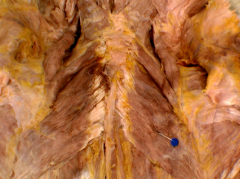
|
-origin: spines of T2-T5 -insertion: medial border of scapula -nerve: dorsal scapular nerve (C5) -action: adducts scapula |
|
|
dorsal scapular nerve |
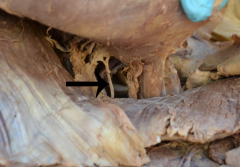
|
-C5 -branches from the roots of the brachial plexus -innervates the rhomboids and frequently the levator scapulae -pierces the scalenus medius to reach the posterior cervical triangle |
|
|
dorsal scapular artery |
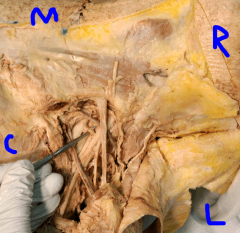
|
-branch of thyrocervical trunk of the subclavian artery -suppleis the levator scapulae, rhomboids, and serratus anterior muscels -accompanies the dorsal scapular nerve |
|
|
serratus posterior inferior |

|
-origin: supraspinous ligament and spines T11-L3 -insertion: lower border of ribs 9-12 -nerve: intercostal nerve T9-T12 -action: depresses ribs |
|
|
posterior humeral circumflex artery |
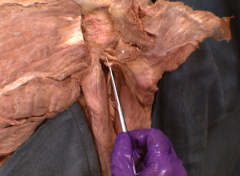
|
-branches from the axillary artery -runs posteriorly with the axillary nerve through the quadrangular space bounded by the teres minor and teres major muscles, the long head of the triceps brachii, and the humerus -anastomoses with the anterior humeral circumflex artery and an ascending branch of the profunda brachii artery and also sends a branch to the acromial rete |
|
|
axillary nerve |
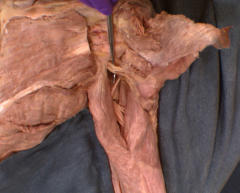
|
-C5-C6 -branches from the posterior cord of the brachial plexus -innervates the deltoid (by its anterior and posterior branches) and the teres minor (by its posterior branch) -gives rise to the lateral brachial cutaneous nerve -passes posteriorly through the quadrangular space accompanied by the posterior circumflex artery -winds around the surgical neck of the humerus (may be injured when this part of the bone is fractured) |
|
|
triceps |

|
-origin: long head=infraglenoid tubercle; lateral head= superior to radial groove of humerus; medial head= inferior to radial groove -insertion: posterior surface of olecranon process of ulna -nerve: radial -action: extends forarm |
|
|
supraspinatus |
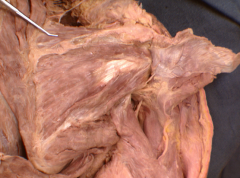
|
-origin: supraspinous fossa -insertion: superior facet of the greater tubercle of humerus -nerve: suprascpular -action: abducts arm |
|
|
suprascapular nerve |
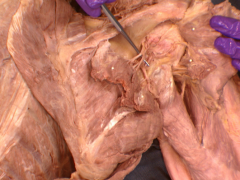
|
-C5-C6 -branches from the upper trunk of the brachial plexus -runs laterally across the posterior cervical triangle -passes through the scapular notch under the superior transverse scapular ligament (navy runs under the bridge) -supplies the supraspinatus muscle and the shoulder joint then descends through the notch of the scapular neck to innervate the infraspinattus muscle
|
|
|
infraspinatus |

|
-origin: infraspinous fossa -insertion: middle facet of greater tubercle of humerus -nerve: suprascapular -action: rotates arm laterally |
|
|
teres minor |
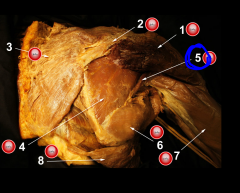
|
-origin: upper portion of lateral border of scapula -insertion: lower facet of greater tubercle of humerus -nerve: axillary -action: rotates arm laterally |
|
|
teres major |

|
-origin: dorsal surface of inferior angle of scapula -insertion: medial lip of intertubercular groove of humerus -nerve: lower subscapular -action: adducts and rotates arm medially |
|
|
lower subscapular nerve |
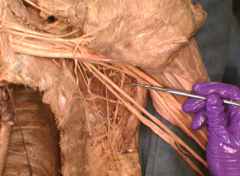
|
-C5-C6 -branches from the posterior cord of the brachial plexus -innervates the lower part of the subscapularis and teres major muscles |
|
|
thoracodorsal artery |

|
-branches from the subscapular artery (which branches from the axillary artery) -accompanies the thoracodorsal nerve -supplies the latissimus dorsi muscle and the lateral thoracic wall |
|
|
circumflex scapular artery |
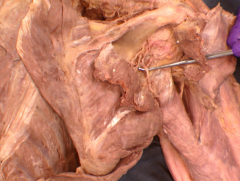
|
-branches from the subscapular artery (which branches from the axillary artery) -passes posteriorly into the triangular space bounded by the subscapularis muscle and the teres minor muscle above, the teres major muscle below, and the long head of the brachii laterally -ramifies in the infraspinous fossa and anastomoses with branches of the dorsal scapular and suprascapular arteries |
|
|
subscapularus |
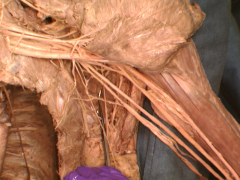
|
-origin: subscapular fossa -insertion: lesser tubercle of humerus -nerve: upper and lower sub scapular -action: adducts and rotates arm medially |
|
|
upper subscapular nerve |
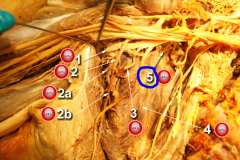
|
-C5-C6 -branches from the posterior cord of the brachial plexus -innervates the upper portion of the subscapularis muscle |
|
|
rotator cuff |

|
|
|
|
suprascapular artery |
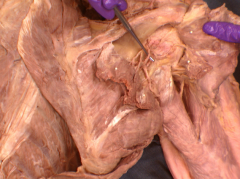
|
-branch of the thyrocervical trunk of the subclavian artery -passes over the superior transverse scapular ligament (army runs over the bridge) -anastomoses with the deep branch of the transverse cervical artery and the circumflex scapular artery around the scapula providing a collateral circulation -supplies the supraspinatus and infraspinatus and the shoulder and acromioclavicular joints |
|
|
quadrangular space |

|
-bordered by the teres minor (superiorly), teres major (inferiorly), long head of the triceps (medially), and the humerus (laterally) -passageway by which the axillary nerve and the posterior humeral circumflex artery exit the axilla |
|
|
triangular space |
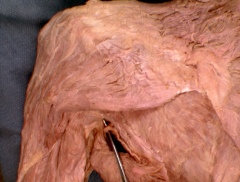
|
-bordered by the teres minor superiorly, teres major inferiorly, and the long head of the triceps laterally -passageway by which the circumflex scapular artery exits the axilla |
|
|
cervical vertebrae |
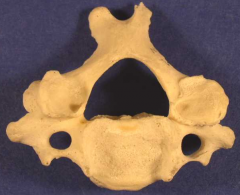
|
-C1-C7 -C1=atlas: supports the skull; is the widest; no body or spine -C2=axis: smallest transverse process; characterized by dens that projects superiorly and articulates with the anterior arch of the atlas --> pivot -C1-C6: typical; short spine and transverse processes with tubercles and foramina -C7: vertebra prominens due to long spinous process that provides attachement site |
|
|
thoracic vertebrae |
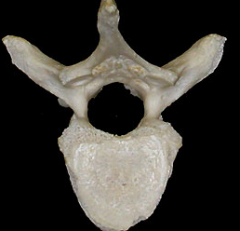
|
-T1-T12 -have costal facets on body: superior articulates with corresponding rib, inferior articulates with subjacent rib -has transverse process that articulates with tubercle of rib |
|
|
lumbar vertebrae |
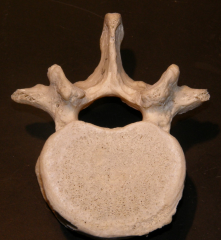
|
-L1-L5 -large bodies, sturdy laminae, no costal facets -L5 has largest body -massive transverse process |
|
|
sacrum |

|
-5 fused vertebrae -4 pairs of foramina for the exit of the ventral and dorsal primary rami of the first 4 sacral nerves -strength+stability --> pelvis |
|
|
coccyx |
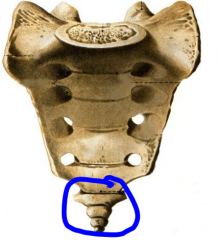
|
-5 fused coccygeal vertebrae -provides attachment for coccygeus and levator ani muscles |
|
|
spinal canal |
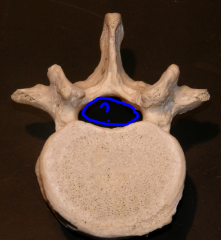
|
-aka vertebral foramina -formed by the vertebral bodies and vertebral arches (pedicles and laminae) -collectively transmit the spinal cord with its meningeal covering, nerve roots, and associated vessles |
|
|
body of vertebrae |
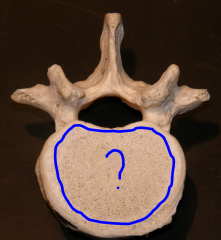
|
-short cylinder, supports weight, and is separated and also bound together by the intervertebral discs forming cartilaginous joints -costal facets that articulate with the heads of ribs |
|
|
pedicles |
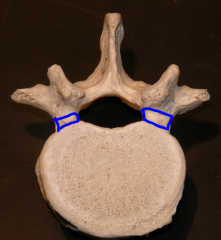
|
-along with the laminae and vertebral body forms the vertebral foramen to protect the spinal cord and associated structures |
|
|
laminae |
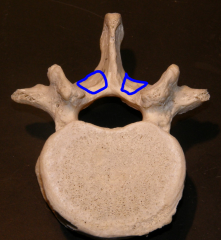
|
-along with the pedicles and vertebral body forms the vertebral foramen to protect the spinal cord and associated structures |
|
|
spinous process |
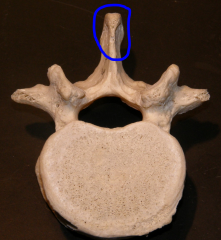
|
-projects posteriorly from the junction of two laminae of the vertebral arch -is bifid in the cervical region, spine-like in thoracic region, and oblong in the lumbar |
|
|
transverse process |
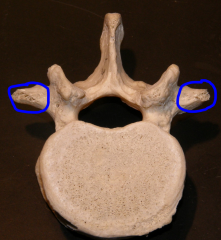
|
-project laterally on each side from the junction of the pedicle and lamina -articulate with tubercles of ribs 1-10 in the thoracic region -have transverse foramina in the cervical region |
|
|
superior costal facets |

|
-articulate with corresponding ribs |
|
|
inferior costal facets |
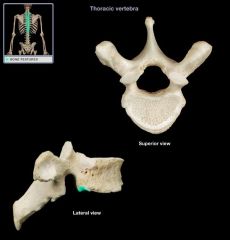
|
-articulate with subjacent ribs |
|
|
superior articular process |

|
-projections from the junction of the laminae and pedicles -articulate with other articular processes of the arch above forming plane synovial joints |
|
|
inferior articular process |
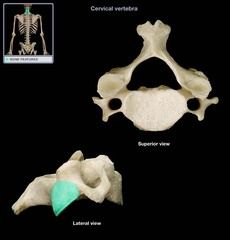
|
-projections from the junction of the laminae and pedicles -articulate with other articular processes of the arch below forming plane synovial joints |
|
|
intervertebral foramen |

|
-located between the inferior and superior surfaces of the pedicles of adjacent vertebrae -transmit the spinal nerves and accompanying vessels as they exit the vertebral canal |
|
|
anterior longitudinal ligament |

|
-runs from skull to sacrum on anterior surface of vertebral bodies and intervertebral discs -narrowest at the upper end -limits extension of spinal column and resists gravitational pull |
|
|
posterior longitudinal ligament |
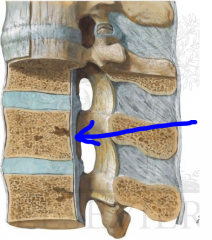
|
-interconnects the vertebral bodies and intervertebral discs -narrows as it descends -supports the posterior bodies from within the spinal canal -limits flexion and resists grav |
|
|
ligamentum flavum |
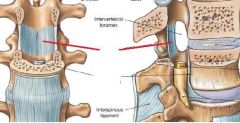
|
-connects the laminae of two adjacent vertebrae -maintains upright posture -forms posterior wall of spinal canal (punctured in lumbar puncture) |
|
|
interspinous ligaments |

|
|
|
|
supraspinous ligament |
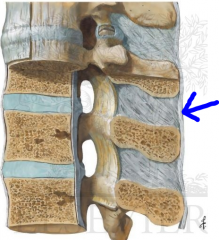
|
|
|
|
errector spinae |

|
-divided into three columns: spinalis, longissimus, and iliocostalis -origin: sacrum, illium, ribs, spinous processes of lumbar and lower thoracic vert. -insertion: ribs; ribs and transverse processes; spinous processes -innervated by posterior rami of spinal nerves -extend, rotate, laterally flex vertebral column and head |
|
|
spinalis |
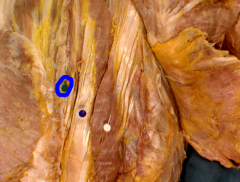
|
-origin: sacrum, illium, ribs, spinous processes of lumbar and lower thoracic vert. -insertion: spinous processes -innervated by posterior rami of spinal nerves -extend, rotate, laterally flex vertebral column and head |
|
|
longissimus |
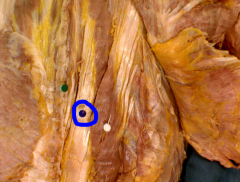
|
-origin: sacrum, illium, ribs, spinous processes of lumbar and lower thoracic vert. -insertion: ribs and transverse processes -innervated by posterior rami of spinal nerves -extend, rotate, laterally flex vertebral column and head |
|
|
iliocostalis |
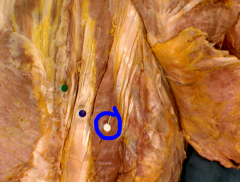
|
-origin: sacrum, illium, ribs, spinous processes of lumbar and lower thoracic vert. -insertion: ribs -innervated by posterior rami of spinal nerves -extend, rotate, laterally flex vertebral column and head |
|
|
transversospinalis |

|
-muscle group deep to the errector spinae -consists of the semispinalis, multifidus, and rotators -extend and rotate the head, neck, and trunk |
|
|
spinal cord |
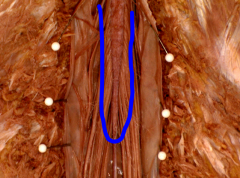
|
-occupies the upper 2/3 of the vertebral canal (to L2 in adults) -enveloped by 3 meninges -cervical and lumbar enlargements for supply of upper and lower limbs -contains grey matter; surrounded by white matter -grows slower than vertebral column during development (ends at L3 in newborn) |
|
|
anterior motor root |

|
|
|
|
posterior sensory root |
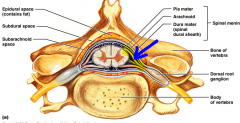
|
|
|
|
anterior rami |
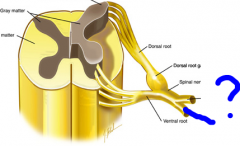
|
-form the plexuses and the intercostal and subcostal nerves |
|
|
posterior rami |
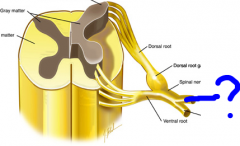
|
-innervate the skin and deep muscles of the back |
|
|
conus medullaris |

|
-conical end of spinal cord -terminates at L2 or the intervertebral disk L1-L2 |
|
|
filum terminale |
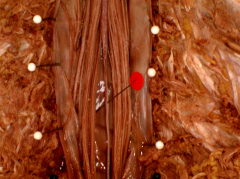
|
-prolongation of pia mater at L2 -lies in the cauda equina -ends at S2 by attaching to the apex of the dural sac -blends with dura at apex and then the dura continues downward as the filum terminale externum |
|
|
cauda equina |

|
-lash of dorsal and ventral roots of the lumbar and sacral spinal nerves that surround the filum terminale -located in the subarachnoid space, below the conus medullaris -free to float in the CSF --> not damaged by spinal tap |
|
|
pia mater |

|
-innermost meningeal layer; cannot be dissected from spinal cord -lateral extensions between dorsal and ventral roots |
|
|
arachanoid mater |

|
-filmy, transparent, spidery layer connected to pia mater by web like trabeculations -forms subarachnoid space that is filled with cerebrospinal fluid (CSF) |
|
|
subarachnoid space |
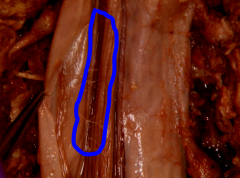
|
-formed by trabeculations between arachnoid and pia -filled with CSF -enlarged suba. space L1-S2 is the lubar cistern |
|
|
dura mater |

|
-tough fibrous outermost layer |
|
|
epidural space |
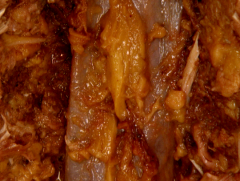
|
-external to dura mater -contains internal vertebral venous plexus and epidural fat |
|
|
dorsal root ganglion |

|
-contains sensory cell bodies |
|
|
multifidis |

|
-origin: sacrum, illium, transverse processes -insertion: spinous processes -innervation: dorsal primary rami -action: extend and rotate the head, neck, and trunk |
|
|
acetabulum |

|
|
|
|
acromioclavicular joint |

|
|
|
|
adductor tubercle |
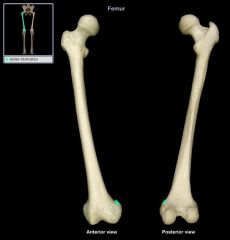
|
|
|
|
anatomical neck of the humerus |

|
|
|
|
anterior inferior iliac spine |

|
|
|
|
anterior superior iliac spine |
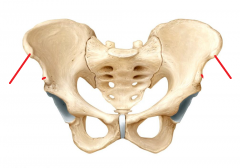
|
|
|
|
apex of patella |

|
|
|
|
base of patella |
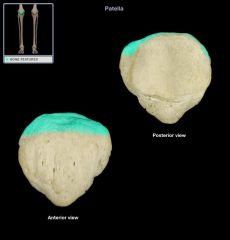
|
|
|
|
calcaneus |

|
|
|
|
capitate |
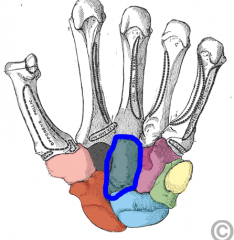
|
|
|
|
cubital fossa |

|
|
|
|
cuboid |
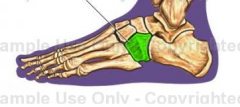
|
|
|
|
cuneiforms |
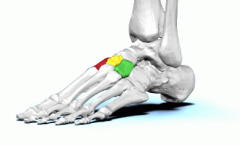
|
|
|
|
femur |

|
|
|
|
fibula |
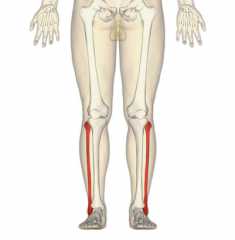
|
|
|
|
fovea |
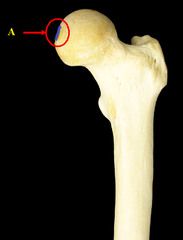
|
|
|
|
gluteal tuberosity |
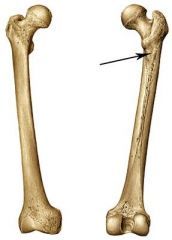
|
|
|
|
greater sciatic notch |
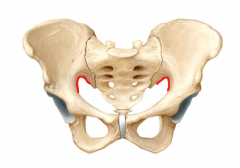
|
|
|
|
greater trochanter |
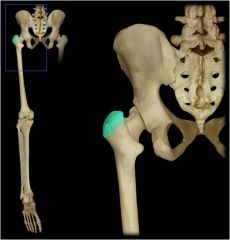
|
|
|
|
hamate |
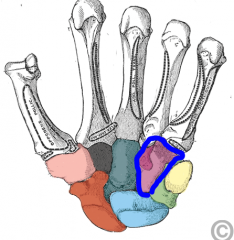
|
|
|
|
head of femur |
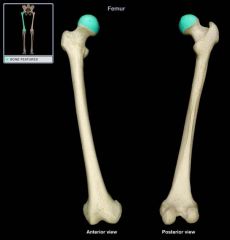
|
|
|
|
head of fibula |
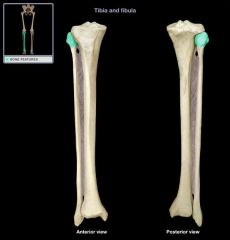
|
|
|
|
head of humerus |
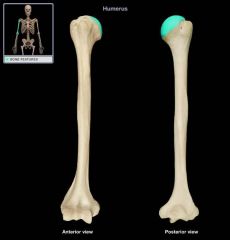
|
|
|
|
head of radius |
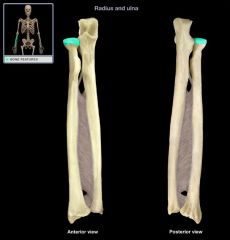
|
|
|
|
iliac crest |

|
|
|
|
ilium |
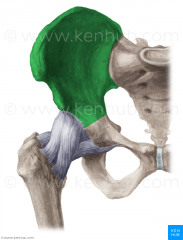
|
|
|
|
inferior rami of pubis |
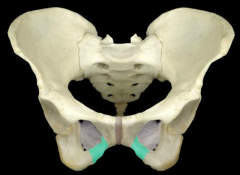
|
|
|
|
intercondylar eminence |
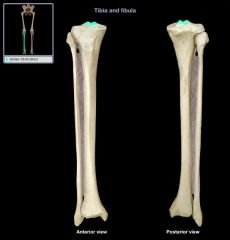
|
|
|
|
intercondylar fossa |
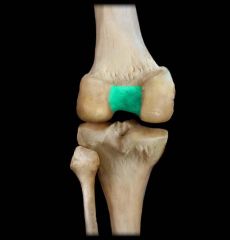
|
|
|
|
intertrochanteric crest |

|
|
|
|
intertrochanteric line |
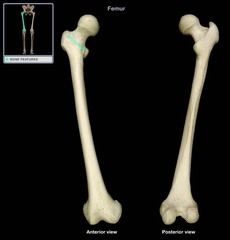
|
|
|
|
ischial spine |
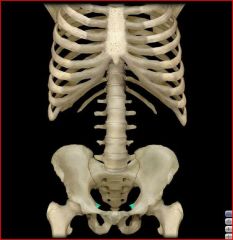
|
|
|
|
ischial tuberosity |
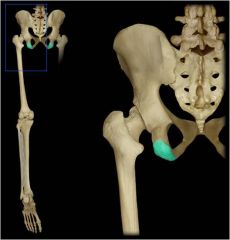
|
|
|
|
ischium |
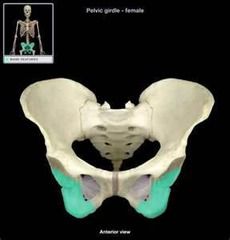
|
|
|
|
lateral condyle of femur |
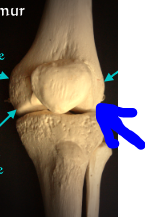
|
|
|
|
lateral condyle of tibia |
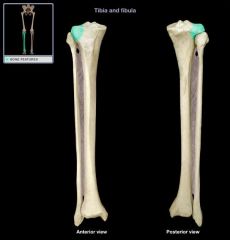
|
|
|
|
lateral epicondyle of femur |
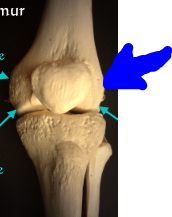
|
|
|
|
lateral malleolus |
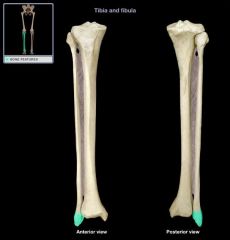
|
|
|
|
lesser sciatic notch |
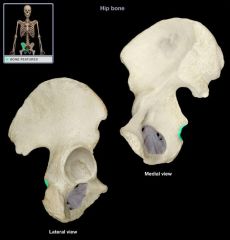
|
|
|
|
lesser trochanter |

|
|
|
|
linea aspera |
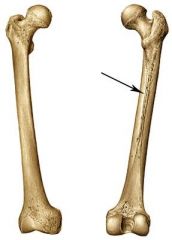
|
|
|
|
lunate |
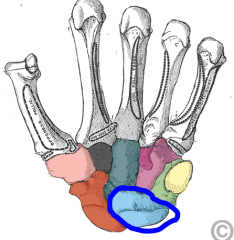
|
|
|
|
medial condyle of femur |

|
|
|
|
medial condyle of tibia |
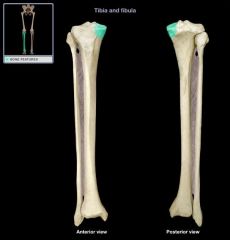
|
|
|
|
medial epicondyle of femur |

|
|
|
|
medial malleolus |

|
|
|
|
metacarpal bones |
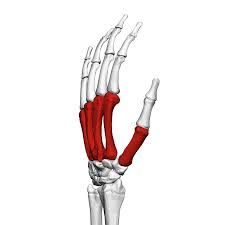
|
|
|
|
metatarsals |

|
|
|
|
middle phalanges |

|
|
|
|
navicular |

|
|
|
|
neck of femur |
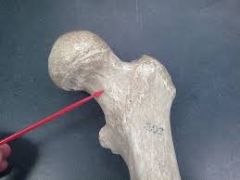
|
|
|
|
neck of radius |

|
|
|
|
obturator foramen |
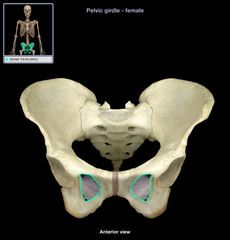
|
|
|
|
patella |
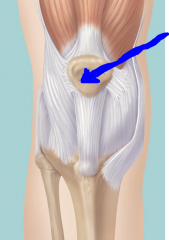
|
|
|
|
pisiform |
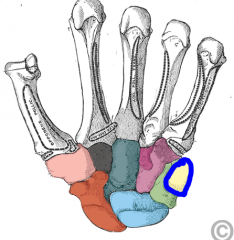
|
|
|
|
popliteal surface |
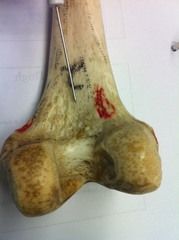
|
|
|
|
posterior inferior iliac spine |
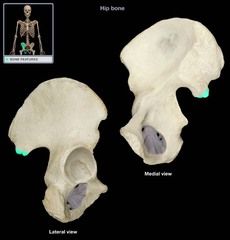
|
|
|
|
posterior superior iliac spine |
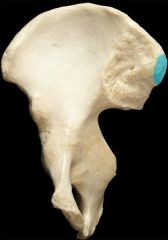
|
|
|
|
proximal phalanges |
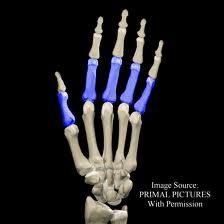
|
|
|
|
pubis |

|
|
|
|
pubic symphysis |

|
|
|
|
pubic tubercle |
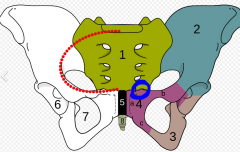
|
|
|
|
scapular notch |
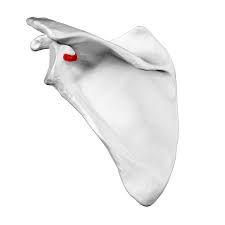
|
|
|
|
superior ramus of pubis |

|
|
|
|
surgical neck of the humerus |

|
|
|
|
talus |
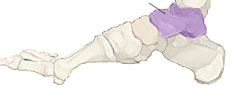
|
|
|
|
tibia |
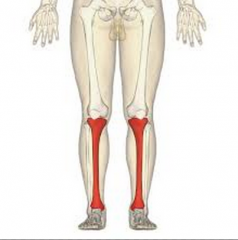
|
|
|
|
tibial tuberosity |

|
|
|
|
trapezium |
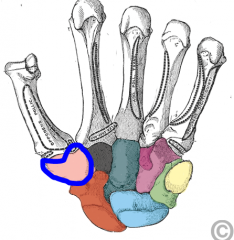
|
|
|
|
trapezoid |
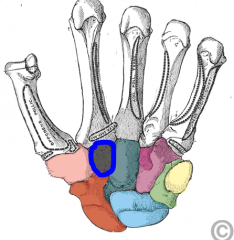
|
|
|
|
triquetrum |

|
|
|
|
trochanteric fossa |
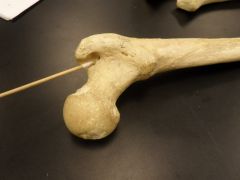
|
|
|
|
radial tuberosity |
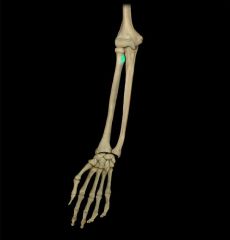
|
|
|
|
abductor digiti minimi |
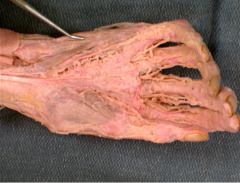
|
|
|
|
abductor pollicis brevis |
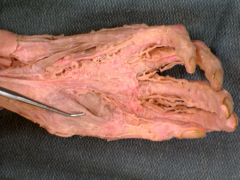
|
|
|
|
abductor pollicis longus |
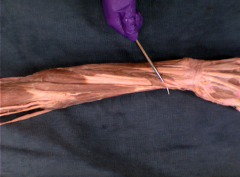
|
|
|
|
adductor brevis |
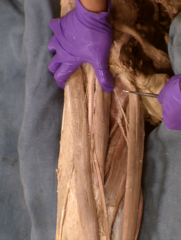
|
|
|
|
adductor canal |

|
|
|
|
adductor longus |
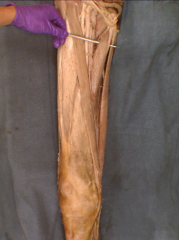
|
|
|
|
adductor magnus |
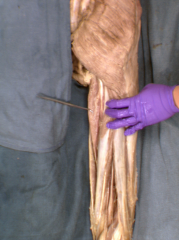
|
|
|
|
adductor pollicis |
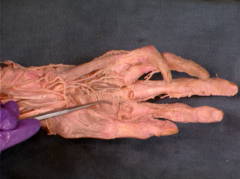
|
|
|
|
anconeus |

|
|
|
|
anterior branch of the obturator nerve |

|
|
|
|
anterior humeral circumflex artery |

|
|
|
|
anterior interosseous artery |
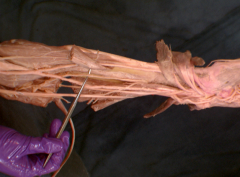
|
|
|
|
anterior interosseous nerve |
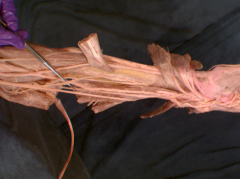
|
|
|
|
basilic vein |

|
|
|
|
biceps brachii |

|
|
|
|
biceps femoris |

|
|
|
|
brachial artery |

|
|
|
|
brachialis |
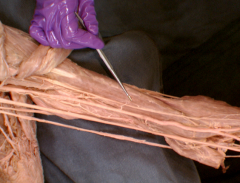
|
|
|
|
brachioradialis |

|
|
|
|
common fibular nerve |
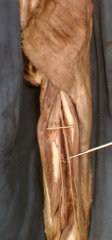
|
|
|
|
common interosseus artery |
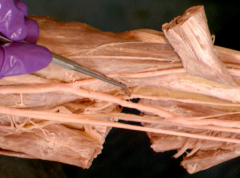
|
|
|
|
coracobrachialis |

|
|
|
|
deep brachial artery |
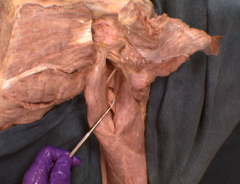
|
|
|
|
deep femoral artery |
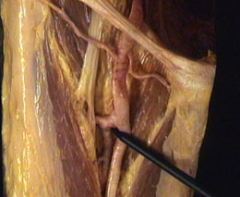
|
|
|
|
deep palmar arterial arch |

|
|
|
|
deep radial nerve |

|
|
|
|
dorsal interossei |
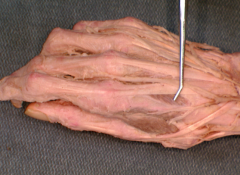
|
|
|
|
extensor carpi radialis brevis |

|
|
|
|
extensor carpi radialis longus |
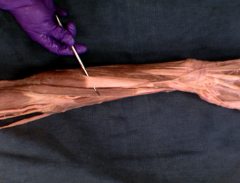
|
|
|
|
extensor carpi ulnaris |

|
|
|
|
extensor digiti minimi |

|
|
|
|
extensor digitorum |
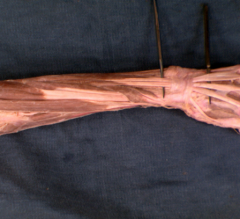
|
|
|
|
extensor expansion hood |

|
|
|
|
extensor indicis |
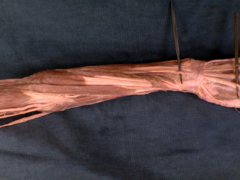
|
|
|
|
extensor pollicis brevis |
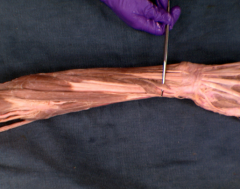
|
|
|
|
extensor pollicis longus |
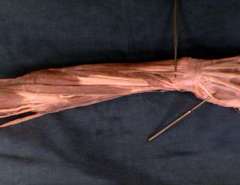
|
|
|
|
femoral artery |
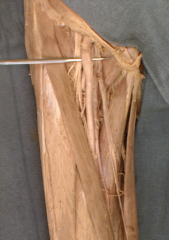
|
|
|
|
femoral nerve |
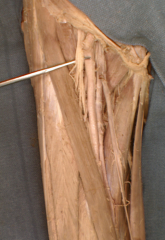
|
|
|
|
femoral sheath |
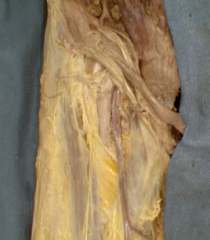
|
|
|
|
femoral triangle |

|
|
|
|
femoral vein |
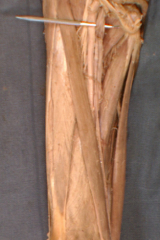
|
|
|
|
flexor carpi radialis |
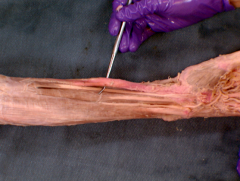
|
|
|
|
flexor carpi ulnaris |
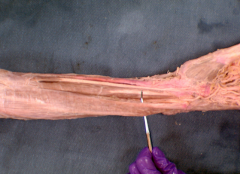
|
|
|
|
flexor digiti minimi |
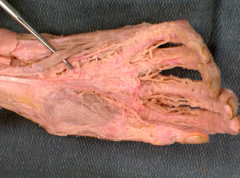
|
|
|
|
flexor digitorum profundus |
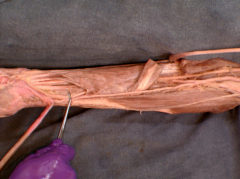
|
|
|
|
flexor digitorum superficialis |
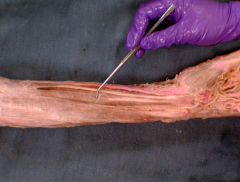
|
|
|
|
flexor pollicis brevis |
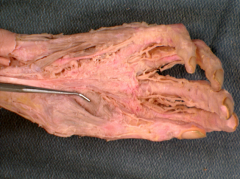
|
|
|
|
flexor pollicis longus |
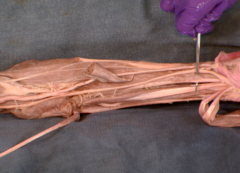
|
|
|
|
flexor retinaculum |
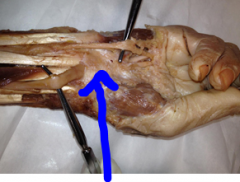
|
|
|
|
gluteus maximus |

|
|
|
|
gluteus medius |
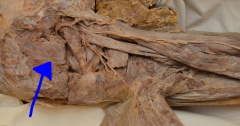
|
|
|
|
gluteus minimus |

|
|
|
|
gracilis |
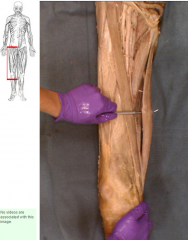
|
|
|
|
great saphenous vein |
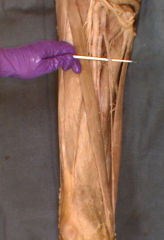
|
|
|
|
guyon canal |
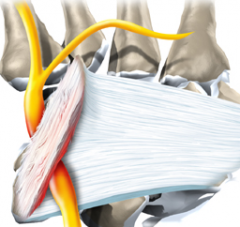
|
|
|
|
iliopsoas |

|
|
|
|
iliotibial tract |
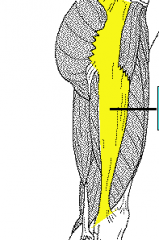
|
|
|
|
inferior gemellus |

|
|
|
|
inferior gluteal nerve |
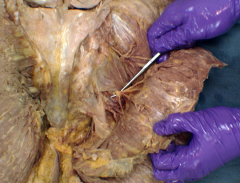
|
|
|
|
inguinal ligament |
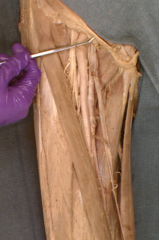
|
|
|
|
lateral antebrachial cutaneous nerve |
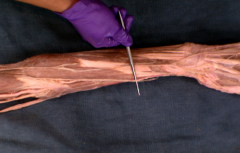
|
|
|
|
lateral femoral circumflex artery |
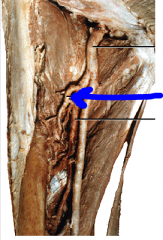
|
|
|
|
lower trunk of the brachial plexus |
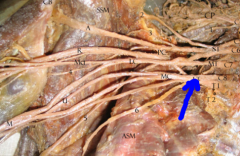
|
|
|
|
lumbrical |
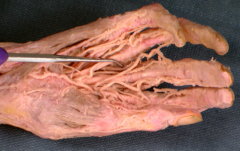
|
|
|
|
medial antebrachial cutaneous nerve |
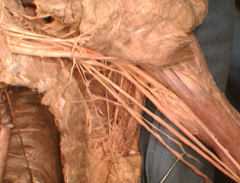
|
|
|
|
medial brachial cutaneous nerve |
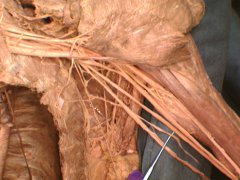
|
|
|
|
medial femoral circumflex artery |

|
|
|
|
median cubital vein |

|
|
|
|
median nerve |
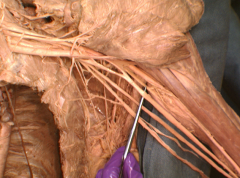
|
|
|
|
middle trunk of the brachial plexus |
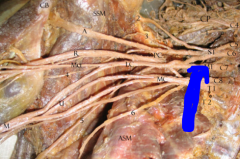
|
|
|
|
musculocutaneous nerve |
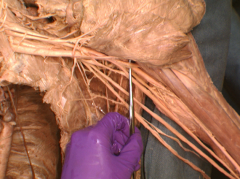
|
|
|
|
obturator externus |
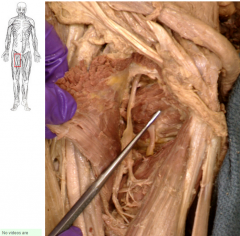
|
|
|
|
obturator internus |

|
|
|
|
obturator nerve |

|
|
|
|
opponens digiti minimi |
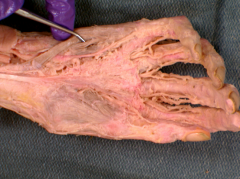
|
|
|
|
opponens pollicis |
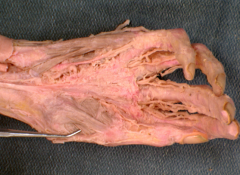
|
|
|
|
palmar aponeurosis |
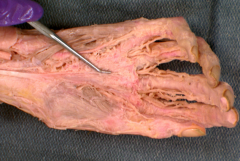
|
|
|
|
palmar interossei |
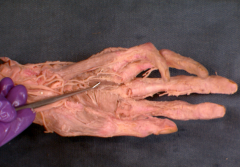
|
|
|
|
palmaris longus |

|
|
|
|
pectineus |

|
|
|
|
perforating arteries |

|
|
|
|
piriformis |

|
|
|
|
popliteal artery |

|
|
|
|
popliteal vein |
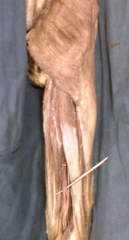
|
|
|
|
posterior antebrachial cutaneous nerve |

|
|
|
|
posterior cord of the brachial plexus |
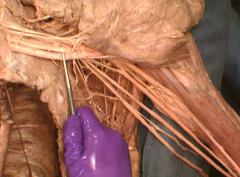
|
|
|
|
posterior division of obturator nerve |
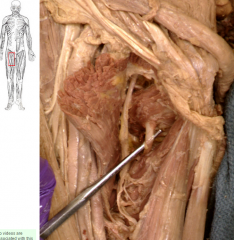
|
|
|
|
posterior femoral cutaneous nerve |
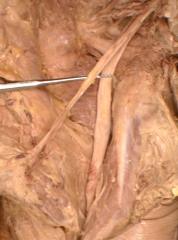
|
|
|
|
posterior interosseus artery |

|
|
|
|
pronator quadratus |
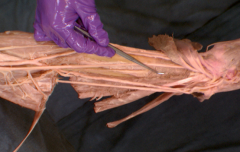
|
|
|
|
pronator teres |
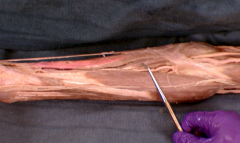
|
|
|
|
quadratus femoris |
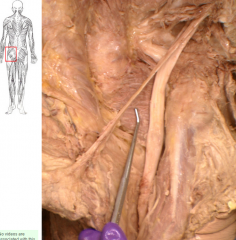
|
|
|
|
radial artery |
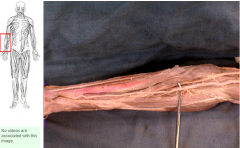
|
|
|
|
radial nerve |
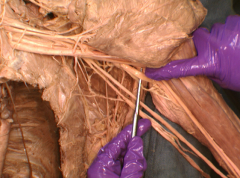
|
|
|
|
rectus femoris |
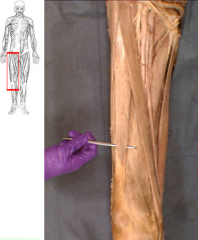
|
|
|
|
recurrent branch of the median nerve |

|
|
|
|
saphenous nerve |

|
|
|
|
sartorius |

|
|
|
|
sciatic nerve |

|
|
|
|
semimembranosus |

|
|
|
|
semitendinosus |
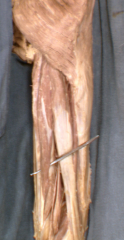
|
|
|
|
serratus posterior superior |
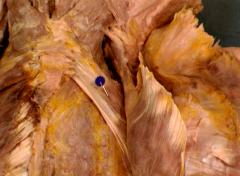
|
|
|
|
subscapular artery |
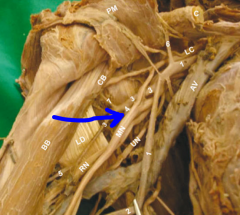
|
|
|
|
superficial palmar arch |
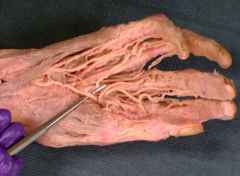
|
|
|
|
superficial radial nerve |
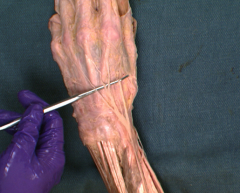
|
|
|
|
superior gemellus |

|
|
|
|
superior gluteal artery |
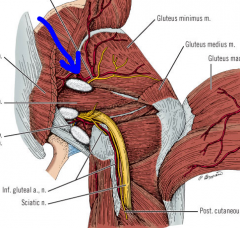
|
|
|
|
superior gluteal nerve |

|
|
|
|
superior thoracic artery |
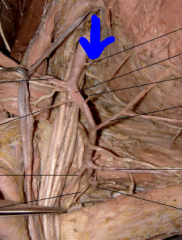
|
|
|
|
supinator |
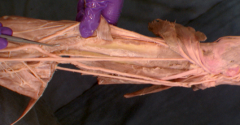
|
|
|
|
tensor fascia latae |

|
|
|
|
thoracodorsal nerve |
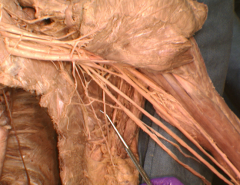
|
|
|
|
tibial nerve |

|
|
|
|
ulnar artery |

|
|
|
|
ulnar nerve |

|
|
|
|
ulnar recurrent artery |
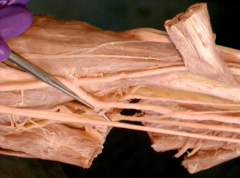
|
|
|
|
upper trunk of the brachial plexus |

|
|
|
|
vastus intermedius |
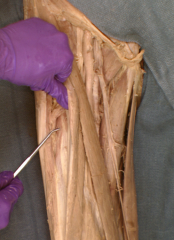
|
|
|
|
vastus lateralis |
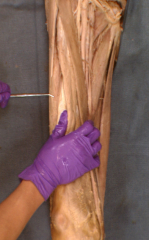
|
|
|
|
vastus medialis |
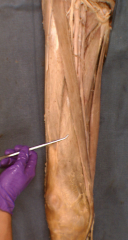
|
|
|
|
abductor digiti minimi (foot) |

|
|
|
|
abductor hallucis |

|
|
|
|
anterior cruciate ligament |
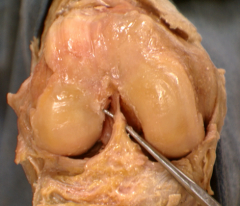
|
|
|
|
anterior tibial artery |
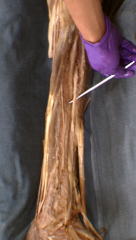
|
|
|
|
deep fibular nerve |

|
|
|
|
extensor digitorum brevis |
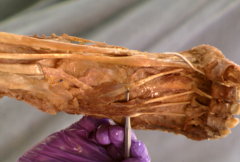
|
|
|
|
extensor digitorum longus |
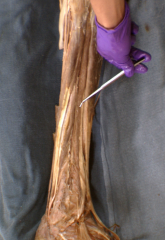
|
|
|
|
extensor hallucis longus |
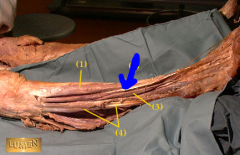
|
|
|
|
fibular artery |

|
|
|
|
fibular collateral ligament |

|
|
|
|
fibularis brevis |
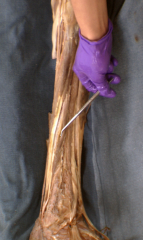
|
|
|
|
fibularis longus |

|
|
|
|
flexor digitorum brevis |

|
|
|
|
flexor digitorum longus |
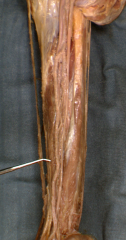
|
|
|
|
flexor hallucis longus |
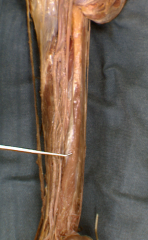
|
|
|
|
flexor hallucis brevis lateral head |

|
|
|
|
flexor hallucis brevis medial head |

|
|
|
|
gastrocnemius |

|
|
|
|
iliofemoral ligament |

|
|
|
|
lateral meniscus |

|
|
|
|
lumbrical (foot) |
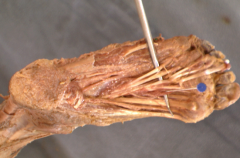
|
|
|
|
medial meniscus |
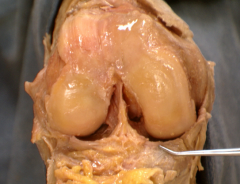
|
|
|
|
oblique popliteal ligament |
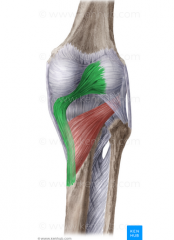
|
|
|
|
fibularis tertius |

|
|
|
|
plantaris |
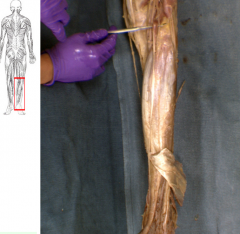
|
|
|
|
popliteus |
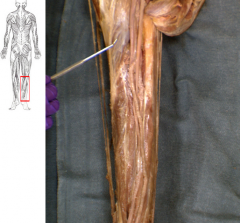
|
|
|
|
posterior cruciate ligament |

|
|
|
|
posterior tibal arteries |
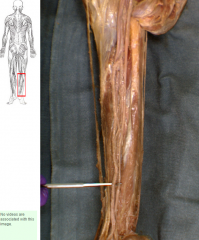
|
|
|
|
pubofemoral ligament |
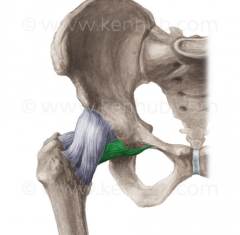
|
|
|
|
quadratus plantae |

|
|
|
|
soleus |
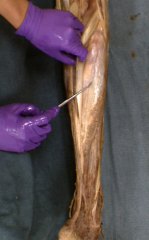
|
|
|
|
superficial fibular nerve |

|
|
|
|
tibial collateral ligament |

|
|
|
|
tibialis anterior |

|
|
|
|
tibialis posterior |

|
|
|
|
transverse ligament (knee) |
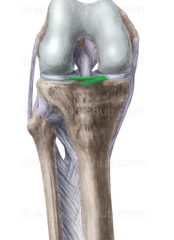
|
|

